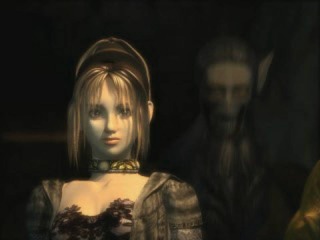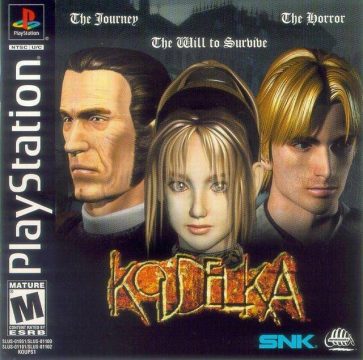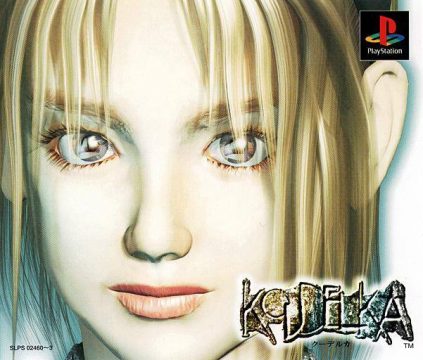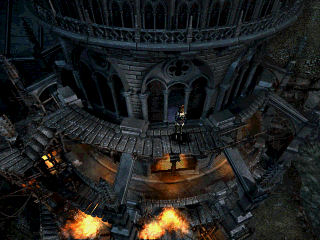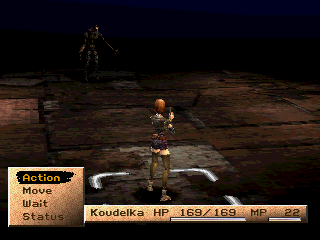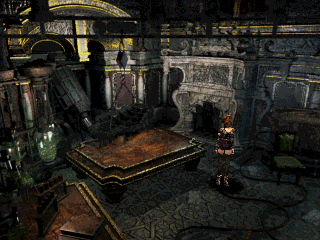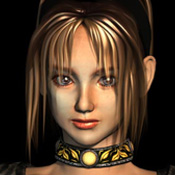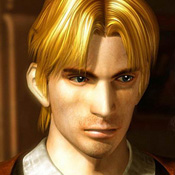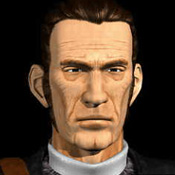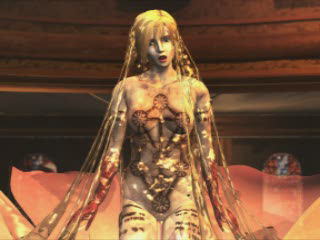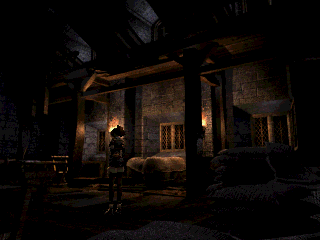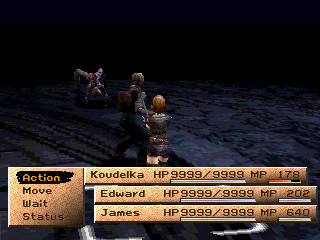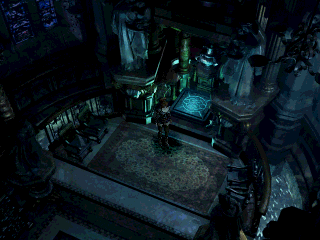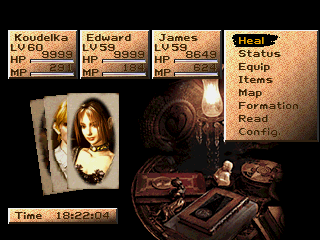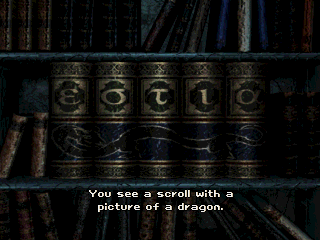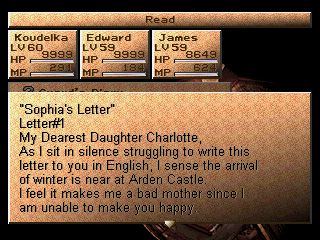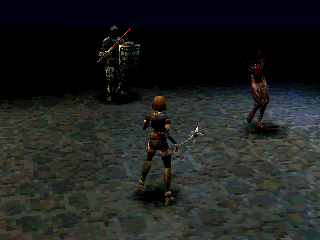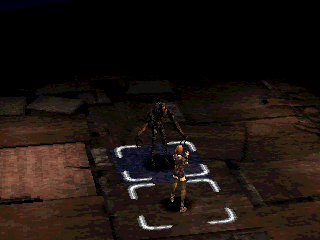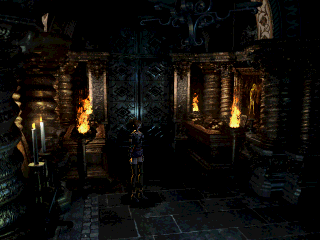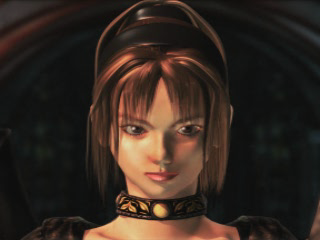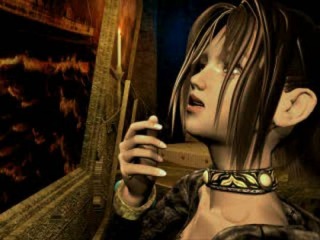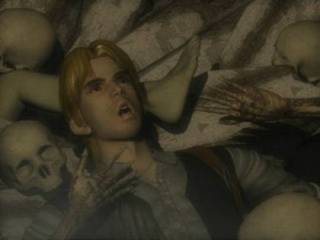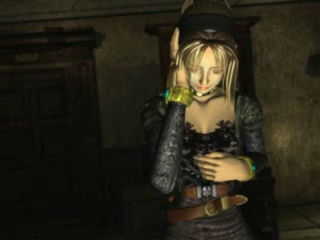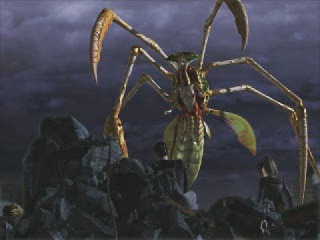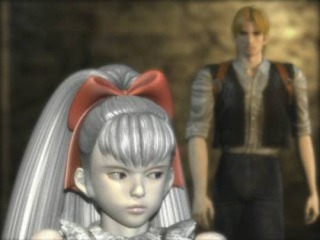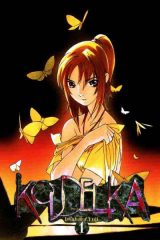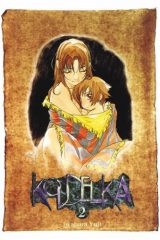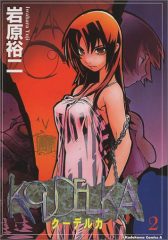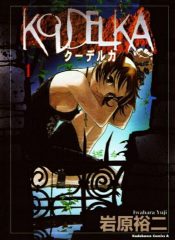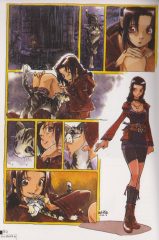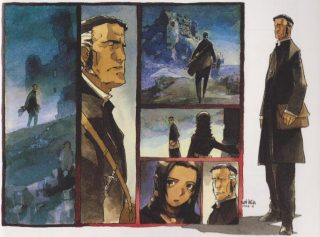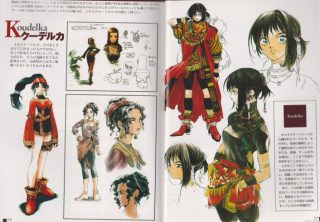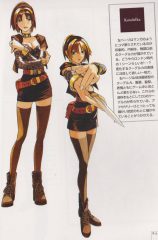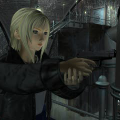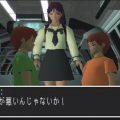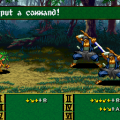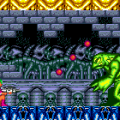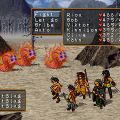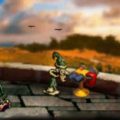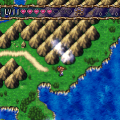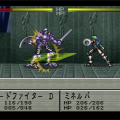While none of the “proper” Shadow Hearts games saw daylight until the PS2 era, a significant portion of their groundwork was laid here, in what was fated to become a spiritual precursor to the series. While Koudelka resembles its descendants only vaguely in most respects, it unquestionably sets in place both the story elements and overall tone that would help to define those more illustrious offshoots.
In 1997, SNK (of King of Fighters and Metal Slug fame) founded a small internal development house and dubbed it Sacnoth, after a mythical sword from a short story by Irish author Lord Dunsany. At its helm was Hiroki Kikuta, who up to that point had spent most of his career within the video game industry as a composer, most famously for Square’s SNES entries in the Seiken Densetsu (“Mana”) series. His first (and, as it turns out, last) major project with the new company was a largely unprecedented cross-breed: an RPG that would follow primarily in the footsteps, not of Final Fantasy or Dragon Quest, but the suddenly-popular “survival horror” genre.
Kikuta threw himself and his team headlong into the project, even organizing a group “field trip” to Wales for some on-location research; as gamer lore would have it, however, the development cycle was marred by numerous disagreements among the staff over just how far in a Resident Evil-esque direction they ought to venture. The eventual final product of this group’s disjointed collective energy, though retaining vestiges of its original creative vision, ends up succeeding only sporadically in its stated mission to turn the tired old JRPG on its ear.
Unlike most role-playing releases, which are all but expected to span vast worlds or even multiple time periods, Koudelkafirmly plants its stakes at the tail end of the 1800’s and never ventures outside the walls of a single, remote Welsh monastery. The titular protagonist, having experienced a series of foreboding visions connected to the place, has journeyed there to investigate matters in person: before long, much to her chagrin, she finds herself saddled with a pair of fellow unwelcome interlopers. The trio must quickly find a way to work together, figure out what’s going on, put a stop to it, and make it out alive.
Characters
Koudelka Iasant
A young gypsy medium with a checkered past, an unknown spirit’s voice beckons her to Nemeton Monastery, and she has little real choice but to comply. Attitude-wise Koudelka is all business, with an unrelenting, acidic streak: her mind is almost exclusively focused on solving the mystery at hand, whatever the cost, and she won’t hesitate to chew out anybody who threatens to slow her down, whether they mean to or not. It’s not until late in the story that the player finds out why she’s more devoted to her often-grisly line of work than to the people around her.
Edward Plunkett
Koudelka’s first face-to-face meeting inside the monastery walls comes courtesy of this wounded but scrappy fellow, which is fortunate for both of them since her second is with a nearby monster eager to finish them both off. Having journeyed to Aberystwyth to confirm (and possibly profit from) an inflammatory rumor he’d heard in London, Edward quickly encounters more than he bargained for, and is forced to stick with Koudelka to have any chance of escaping in one piece. While his upbeat, earthy mannerisms at first invite only scorn, he perseveres and gradually builds a bit of rapport between them. His name, not coincidentally, mirrors the birth name of the aforementioned Lord Dunsany.
James O’Flaherty
A bishop who journeys to Nemeton on a rather murky “mission from God”, the aggressively pious and dogmatic O’Flaherty wastes no time in rubbing both of his newfound companions the wrong way…right after they’ve saved his hide from one of the mansion’s creepy creatures, no less. His ironclad spiritual convictions are at once his greatest strength and his Achilles’ heel, granting an indomitable drive and sense of purpose whilst simultaneously preventing him from accepting the obvious at times; if James’ conviction threatens to waver for any reason his personality pulls an instant 180.
As was mentioned earlier, you’ll spend the game’s entirety trapped inside a single building: the place is bigger than it might appear at first, but your journey is still a relatively short one for an RPG, despite spanning four discs. Much of the time you do spend here will be devoted to carefully exploring every fixed-camera room’s numerous nooks and crannies in search of hidden items and secret passages; your character’s default walk is thus slow and deliberate, though holding the “cancel” button can double as a “run” command.
Barreling full speed ahead is often unwise, however, as there’s lots of stuff to find, and you’ll end up needing most of it – while some important pickups are immediately visible, many less-obvious points of interest need to be sniffed out. If you watch Koudelka closely in the field you can see her turn her head towards nearby things you should investigate, though in practice snuggling up against walls and objects while mashing “confirm” will often suffice, if inelegantly.
While a majority of the puzzles you need to solve to progress aren’t overly difficult, you’ll occasionally need to backtrack a ways for something you missed: you do find a map early on, but it’s rather vague, so you’ll have to get accustomed to the place’s layout largely on your own. Fortunately, while full-fledged save points are somewhat widely dispersed, many rooms give players the opportunity to “quick save” upon entering them, meaning that you’re never all that far from an opportunity to stop and take a break if you need to.
Naturally, like most any old and foreboding bit of architecture, Nemeton is populated by a vibrant, close-knit community of bloodthirsty eldritch critters, and as you wander around you’ll randomly encounter them and be spirited away to the Battle screen. Fights in Koudelka resemble a simplified version of the system used in many Strategy-RPG (SRPG) titles: you and your adversaries appear at opposite ends of a flat 5×7 grid, and when ready everyone can Move (up to three spaces total) and Act once apiece, though choosing to Wait instead causes one’s next turn to come up faster. Neither the player nor his enemies, under most circumstances, can move past the front-most member on the opposing side, so advancing rapidly can limit the opposition’s mobility; in exchange, physical attacks can be aimed diagonally as well as straight ahead, and have a chance to knock the target backwards.
Magic and items, for their part, can hit anywhere on the field, though it takes a bit of time to charge up an incantation; everyone in your party has access to the same spell list, so as long as someone’s got enough MP he or she can cast anything you’ve learned. Honestly there’s not a heckuva lot else to the fighting – certain offensive equipment (including guns, which need to be regularly reloaded) allows for attacks from farther away, and there’s a mostly-standard handful of enemy elemental weaknesses and status ailments to consider, but other than that if you can walk up to something and smack it you’ve got the essentials down. It should be noted that while you unfortunately can’t take back mistaken commands mid-turn, you do have the handy ability to switch weapons (at the cost of your current Action) and can also check an active character’s stat list freely; hardly make-or-break amenities, but you’ll still appreciate having them.
Koudelka‘s experience system tacks a bit of flexibility onto your long-term strategy: when a character levels up, you’re free to distribute several “bonus” stat points between his/her eight parameters however you see fit, giving you some freedom to tailor your party to your liking. As the game warns you, however, you do need to take into account that certain stats play off of each other (i.e. a high Strength rating is useless if your Dexterity is too low for you to accurately hit anything). It’s not too huge a deal as long as you aren’t utterly reckless, but be aware that many pieces of equipment (all of which can be equipped by anyone) will lower certain numbers while raising others, so your choices might limit the potential usefulness of certain gear. Speaking of which, as you utilize certain spells and weapon types repeatedly your proficiency with them will gradually increase, leading to wider effect areas and chances for extra hits; again, just make sure not to become overly reliant on any one thing.
While Koudelka‘s uncommon setting and structure infuse it with a fetching dose of personality, the designers were unable to work out all of the kinks that came attached to their ambitions…even more unhappily, excessive ambition is hardly the only problem here. There are no shops (or money, for that matter) in the monastery, which leaves you totally dependent on found items and monster drops for the stuff you’ll need to survive; moreover, the precise nature of the equipment you get is just as vulnerable to the whims of chance. For instance, early on you’ll find a “knife” weapon in a preset location: a knife of some sort will always be there, but its innate type (“Normal”, “Water”, “Vital”, “Mystic”, etc.) will vary with each play-through, and the same goes for nearly every weapon, armor, or accessory you lay hands on from beginning to end. Once you factor in the even less predictable nature of battle rewards, whether you end up with a dominating or near-useless arsenal becomes a roll of the dice.
To be fair, there’s enough loot lying around that you’re unlikely to get completely screwed over, but your inventory’s rather limited storage capacity certainly doesn’t help, especially seeing as you’ll be saddled with certain crucial “event” items across several discs, and thus forced to throw away other stuff you’d rather have kept in the interim. Oh, and did I mention that weapons possess an invisible “durability” rating and will suddenly break in the heat of battle? Then there’s the lack of any means whatsoever to check the HP, weaknesses, or other relevant information about the monsters you meet; none of your foes have even been given names to tell them apart, so when you encounter the inevitable palette swaps it’s up to you to remember whether it’s the blue or yellow one that’s weak against Air.
Perhaps in acknowledgment of their game’s rather haphazard framework, the designers implemented a very mild overall challenge level: while this “solution” does blunt some potential frustrations, it also robs Koudelka of much of the tension that its horror-inspired trappings should be feeding off of. Level-ups not only occur quite frequently, but refill the recipient’s HP and MP when they do, to the point that you’ll rarely need to bother with healing items or spells. Moreover, before long your stats will likely be high enough to make most battles, even bosses (which, by the way, you’re usually free to run from if they’re by some chance giving you trouble), a cakewalk: this goes double if you find yourself lost or stuck and end up unintentionally “grinding” in the interim.
To that end, you’ll probably end up taking more unwanted “side trips” than you’d like, as certain background doors and objects can be tough to make out, and may remain overlooked even after a room has been scoured thoroughly. The somewhat clunky field controls can be an additional hindrance: while they’re unlikely to ever cost you your life (unlike many “pure” horror titles), Koudelka will sometimes fail to climb a box or activate a switch unless you’re directly facing it when you hit the “confirm” button, further dragging down the already-sluggish process of moving things along. An additional handful of comparatively minor design foibles, such as the lack of a pause option during cutscenes (though they can be skipped), don’t make the game feel any less outdated and/or unpolished.
One is treated to a similar impression on the presentational side of things. While not graphically lacking to the point of offense, Koudelka doesn’t look particularly impressive for a late PlayStation title: the pre-rendered environments are mostly static, and the polygonal characters and monsters, stray triangles popping out here and there, definitely could have benefited from some clean-up. The battle screen, despite foregoing any semblance of a background, still loads slowly, and ill-advised cut corners in “exploration” mode further hamstring the air of macabre that the designers were shooting for: most of the moments that could have provided some sorely-needed punch are reduced to bland text blurbs (“As you try to move deeper into the herb garden, a giant plant attacks you!”), hardly the ideal avenue to send chills up expectant spines. On the plus side, the game’s modest selection of CG sequences look pretty good, and the characters’ motion-captured animations have some spark to them: in battle, for example, if you move your character forward he or she will eagerly dash to the spot you specify, but if you choose to back up then they’ll tentatively hop in that direction, keeping their eyes on the enemy.
The aural department of Koudelka is, in a word, sparse: save a handful of battle tracks, the only times you’ll ever hear music are during cutscenes, as the rest of the journey is all but totally unaccompanied. The few songs you do hear aren’t bad at all, employing an appropriately-unsettling mix of exotic tribal instruments and ethereal electronic drones, but the heavy lifting here is taken on by crisply-executed sound effects: dripping water, howling wind, the crackle of a torch, the low vacuum of a tornado spell and the “squish”, “clatter”, or “crunch” of an approaching monster all serve to keep one’s ears perked up nicely. Story scenes are also voiced in English across all regions, and while the lines being read are hardly poetry (and can sometimes be muffled and hard to make out, exacerbated by the lack of a subtitle option in the Western versions), the main performers give them a laudable effort all around.
At the end of the day few are likely to bestow Koudelka with any label much more generous than “mediocre”: the lion’s share of any potential value it holds for contemporary gamers is as a curio rather than something truly worth playing for its own sake. For those familiar with the later Shadow Hearts titles, however, there’s additional appeal here, thanks not only to a handful of kinda-maybe-sorta-essential plot points, but a steady stream of unexpected and charming minutiae: while these stylistic bits and pieces hardly make up for Koudelka‘s larger failings, the developers deserve a pat on the back for carrying them forward into their more successful future projects, allowing their lovingly-applied detail work some much-needed breathing room to stand out.
One such “tradition” that got its start here is the displaying of unique weapons on the character models wielding them, a small but welcome touch, especially considering the era and budget. An even classier artistic streak is discovered within the “Item” menu: not only can players freely rename every single pickup they find, but each listing is accompanied by a brief text description and a lovely hand-drawn illustration. In the years to come, by the way, both the pictures and text would be completely redone for each successive game, recurring items included; in like manner, the physical design of the Judgment Ring is changed up for each Shadow Hearts entry, and upon close inspection contains, among other esoterica, a Latin palindrome and excerpts of 14th-century poetry.
Koudelka and its kin are also notable for featuring multiple endings, whose appearances are affected by certain actions (or inactions) taken by the player – moreover, the lot are rather infamous for making some of the best-hidden catalysts very difficult to find without the help of a guide or FAQ (not in the same realm of “…huh? Seriously?” as, say, Valkyrie Profile, but getting there). Finally, it should be clarified that while Koudelka‘s much-vaunted horror flavoring apparently raised enough eyebrows at the ESRB to earn it a “Mature” rating in the USA, it’s not as harrowing a journey as it makes itself out to be. Most of the gritty, gory stuff you encounter is simply described verbally or glimpsed in the aftermath of an unseen event, as nearly all of the really nasty stuff happens offscreen; for comparison’s sake, the famously stingy USK panel in Germany chose to rate the game “12+”. The Shadow Hearts series largely follows suit, with completely bloodless battles and mostly “high-end T-rating” content at worst.
Despite its creators’ high hopes of breaking new ground and getting themselves noticed, Koudelka failed to resonate much with either critics or consumers, and sales were feeble across all three regions, leading to Kikuta’s abrupt resignation from Sacnoth. There wasn’t a heckuva lot of merchandise left in the game’s wake, but a non-canon three-volume Koudelka manga (or, more likely, its fan translation) originally published in Monthly Ace Next and penned by mangaka Yuji Iwahara (who, interestingly, was once a graphic artist at Hudson Soft) might be worth a look, along with a light novel, drama CD, promo mini-CD and the official soundtrack. A doujin remix compilation (Best Album Vol. 2) by the usually Touhou-centric circle Fragile Online also features an arrangement derived from Koudelka.
Beyond this rather disjointed freshman effort, however, a much more interesting future lay ahead for developers and players alike: the decision was made by Sacnoth’s remaining staffers to take one more shot at unlocking the latent potential stirring within the dark alternate history envisioned for Koudelka.
Manga
